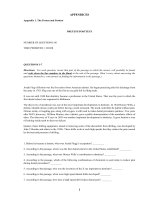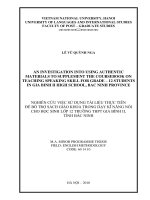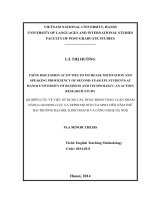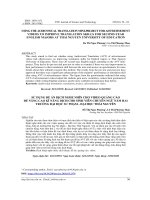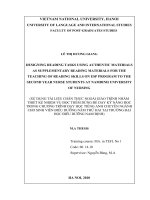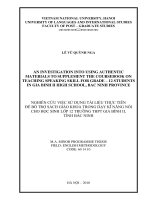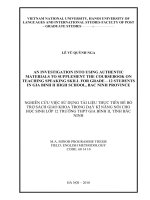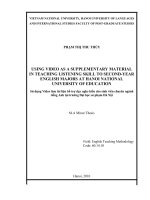USING AUTHENTIC MATERIALS TO SUPPLEMENT THE COURSE BOOK ON ESP PROGRAM FOR SECOND YEAR MEDICAL STUDENTS AT HANOI MEDICAL UNIVERSITY
Bạn đang xem bản rút gọn của tài liệu. Xem và tải ngay bản đầy đủ của tài liệu tại đây (169.5 KB, 17 trang )
Appendices
Appendix 1. The Pretest and Posttest
PRETEST/POSTTEST
NUMBER OF QUESTIONS: 40
TIME PERMITED: 1 HOUR
QUESTIONS 1-7
Directions: For each question, locate that part of the passage in which the answer will probably be found and
write down the line numbers in the blank at the end of the passage. (Don’t worry about answering the
questions themselves; concentrate on finding the information in the passage.)
Josiah Flag of Boston was the first native-born American dentist. He began practicing after his discharge from
the army in 1783. Flag was one of the first to use gold foil in tilling teeth.
It was not until 1840 that dentistry became a profession in the United States. That was the year in which the
first dental school was organized in Baltimore.
The discovery of anesthesia was one of the most important developments in dentistry. In 1844 Horace Wills, a
dentist, inhaled nitrous oxide just before having a tooth extracted. The tooth could then be pulled without pain.
Nitrous oxide, or laughing gas, along with oxygen, is still used to make dental procedures painless. Two years
after Will’s discovery, William Morton, also a dentist, gave a public demonstration of the anesthetic effects of
ether. The discovery of X rays in 1895 was another important development in dentistry. It gave dentists a way
of looking inside teeth to discover defects.
Quieter, faster drilling equipment, aimed at removing some of the discomfort from drilling, was developed by
John V.Borden and others in the 1950s. These drills work at such high speeds that they reduce the pain caused
by the heat and pressure of drilling.
1. Before he became a dentist, what was Josiah Flagg’s occupation? _________
2. According to the passage, where was the first dental school in the United States established? _________
3. According to the passage, what was Horace Wills’s contribution to dentistry? _________
4. According to the passage, which of the following combinations of chemicals is used today to reduce pain
during dental procedures? _________
5. According to the passage, why was the invention of the X ray important to dentistry? ________
6. According to the passage, when were high-speed dental drills developed? ________
7. According to the passage, how does a high-speed drill reduce dental pain? ________
I
QUESTIONS 8-13
Directions: Read the passage, and for each question, choose one best answer based on what is stated in the
passage or on what can be inferred by circling A, B, C, or D.
Another critical factor that plays a part in susceptibility to colds is age. A study done by the University of
Michigan School of Public Health revealed particulars that seem to hold true for the general population.
Infants are the most cold-ridden group, averaging more than six colds in their first year. Boys have more colds
than girls up to age three. After the age of three, girls are more susceptible than boys, and teenage girls
average three colds a year to boys’ two.
The general incidence of colds continues to decline as people move into maturity. Elderly people who are in
good health have as few as one of two colds annually. One exception is found among people in their twenties.
especially women. who show a rise in cold infections. People in this age group are most likely to have young
children. Adults who delay having children until their thirties and forties experience the same sudden increase
in cold infections.
8. The paragraph that precedes this one most probably deals with
(A) minor diseases other than colds
(B) the recommended treatment of colds
(C) another factor that affects susceptibility to colds
(D) methods of preventing colds among elderly people
9. What does the author claim about the study discussed in the passage?
(A) It contains many inconsistencies
(B) It specializes in children.
(C) Its results apparently are relevant for the population as a whole.
(D) It contradicts the results of earlier studies in the field.
10. According to the passage which of the following groups of people is most likely to catch colds?
(A) Infant boys
(B) Young girls
(C) Teenage boys
(D) Elderly women
11. The passage supports which of the following conclusions?
(A) Men are more susceptible to colds than women are.
(B) Children infect their parents with colds.
(C) People who live in a cold climate have more colds than those who live in a warm one.
(D) People who do not have children are more susceptible to colds than those who do.
II
12. The phrase “in this age group” (line 10) refers to
(A) infants
(B) people in their twenties
(C) people in their thirties and forties
(D) elderly people
13. The author’s tone in the passage could best be described as
(A) neutral and objective
(B) humorous
(C) tentative but interested
(D) highly critical
QUESTIONS 14-24
Directions: Choose the most appropriate antibiotic for each of the patients based on the prescribing information
on antibiotics which follows by writing down the particular antibiotic in the blank at the end of the sentence..
14.
A
4
year-old-boy
with
meningitis
due
to
pneumococcus.
He
is
allergic
to
penicillin._____________________
15. A 67-year-old man with a history of chronic bronchitis now suffering from pneumonia. The causative
organism is resistant to tetracyline._________________
16. A 27-year-old woman with urinary tract infection in early pregnancy.______________________
17. A 4-year-old girl with septic arthritis due to haemophilus influenzae._____________________
18. A 18-year-old man with left leg amputation above the knee following a road traffic
accident.___________________________
19. A 50-year-old woman with endocarditis caused by strep. viridans.____________________
20. A 13-year-old girl with disfiguring acne._____________________
21. An 8-year-old boy with tonsillitis due to B-haemolytic streptococcus.____________________
22. A 43-year-old dairyman with brucellosis.________________________
23. A 4-year-old unimmunised sibling of a 2-year-old boy with whooping cough.______________________
24. A 6- year old girl with otitis media. She is allergic to penicillin.
25. A 62- year old man with chronic prostatitis.
III
CEFUROXIME
BENZYLPENCILLIN
Indication: see under Cefaclor; surgical prophy-laxis;
more active against Haemophilus influ-enzae and
Neisseria gonorrhoeae
(Penicillin G)
Cautions; Contra-indications; Side-effects: see under
Cefaclor
Dose: by mouth (as cefuroxime axetil)/ 250 mg twice
daily in most infections including mild to moderate
lower respiratory-tract infection (e.g.bronchitis);
doubled for more severe lower respir-atory-tract
infection or if pneumonia suspected Urinary-tract
infections, 125 mg twice daily, doubled in
pyelonephritis
Gonorrhoea, 1g as a single dose
CHILD over 3 months, 125 mg twice daily, if
necessary doubled in child over 2 years with otitis
media
Gonorrhoea, 1,5g as a single dose by intramuscu-lar
injection (divided between 2 sites)
Surgical prophylaxis, 1,5g by intravenous injection at
induction; may be supplemented with 750 mg
intramuscularly 8 and 16 hours later (abdominal,
pelvic, and orthopaedic operations)
Indications: throat infection, otitis media, streptococcal
endocarditis, meningococcal meningitis, pneumonia (see
table 1); prophylaxis in limb amputation
Cautions: history of allergy; renal impairment; interactions:
Appendix 1 (penicillin)
Contra-indications: penicillin hypersensitivity
Side-effects: sensitivity reactions including urticaria, fever,
joint pains; angioedema; transient leucopenia and
thromboycytopenia; anaphylactic shock in hypersensitive
patients; diarrhoea after administration by mouth
Dose: by slow intravenous injection or by infusion 7,2g
daily in 4-6 divided doses to bacterial endocarditis
Meningococal meningitis. by slow intravenous injection or
by infusion, 2,4g every 4-6 hours;
Important. If meningococcal disease is suspected general
practitioners are advised to give a single injection of
benzylpenicillin by intramuscular or by intravenous
injection before transporting the patient urgently to
hospital. Suitable doses are: ADULT 1,2g; INFANT 300
mg; CHILD 1-9 years 600 mg. 10 years and over as for
adult Prophylaxis in limb amputation section 5.1, table 2
Meningitis, 3g intravenously every 8 hours; CHILD,
200-240 mg/kg daily (in 3-4 divided doses) reduced to
100 mg/kg daily after 3 days or on clinical
improvement; NEONATE. 100 mg/kg daily reduced
to 50 mg/kg daily.
AMPICILLIN
ERYTHROMYCIN
Indications: urinary-tract infections, otitis media,
sinusitis, chronic bronchitis, invasive salmonell-osis,
gonorrhoea
Indications: alternative to penicillin in hypersensitive
patients; campylobacter enteritis, pneumonia. legionnaires’
disease, syphilis, non-gonococcal urethritis, chronic
prostatitis, ance vulgaris (see section 13.6); diphtheria and
whooping cough prophylaxis
Cautions: history of allergy; renal impairment;
erythematous rashes common in glandular fever,
chronic lymphatic leukaemia, and possibly HIV
infection; interactions: Appendix 1 (penicillins)
Contra-indications: penicillin hypersensitivity
Side-effects: nausea, diarrhoea; rashes (discontinue
treatment).
Dose: by mounth, 0.25-1 g every 6 hours, at least 30
minutes before food
Cautions: hepatic and renal impairment; prologation of QT
interval (ventricular tachycardia reported); porphyria (see
section 9.8.2); pregnancy (not know to be harmful) and
breast-feeding (only small mounts in milk); interactions:
Appendix 1 (erythromycin and other macrolides)
Contra-indications: estolate contra-indicated in liver disease
Side-effects: nausea, vomiting, abdominal discomfort,
diarrhoea (antibiotic-associated colitis reported); urticaria,
rashes and other allergic reactions; reversible hearing loss
IV
Gonorrhoea, 2-3.5 g as a single dose with probenecid 1 g
reported after large doses; cholestatic jaundice and cardiac
effects (including chest pain and arrhythmias) also reported
Urinary-tract infections, 500 mg every 8 hours
Dose: by mouth, ADULT and CHILD over 8 years, 250500 ms every 6 hours or 0.5-1 g every 12 hours (see notes
above); up to 4 g daily in severe infections; CHILD up to 2
years 125 mg every 6 doubled for severe infections
By intramuscular injection or intravenous injection or
infusion, 500 mg every 4-6 hours; higher doses in
meningitis
Acne, see section 13.6
CHILD under 10 years, any route, half adult dose
Early syphilis, 500 mg 4 times daily for 14 days
TETRACYCLINE
GENTAMICIN
Indications: exacerbations of chronic bronchitis;
brucellosis (see also notes above), chlamydia,
mycoplasma, and rickettsia; pleural effusions due to
malignancy or cirrhosis; acne vulgaris (see section
13.6)
Indications: septicarmia and neonatal sepsis: meningitis
and other CNS infections; biliary-tract infection acute
pyelonephritis or prostatitis, endocarditis caused by Strep.
viridans or Strep faecalis (with a penicillin): pneumonia in
hospital patients, adjunct in listerial meningitis (section 5.1
table 1)
Cautions: hepatic impairment (avoid intravenous
administration); renal impairment ( see Appendix 3);
rarely causes photosensitivity; interactions: Appendix
1 (tetracylines)
Contra-indications: renal impairment (see Appendix 3),
pregnancy and breast-feeding (see also Appendixes 4
and 5), children under 12 years of age, systemic lupus
erythematosus
Side-effects: nausea, vomiting, diarrhoea; erythema
(discontinue treatment); headache and visual
disturbances may indicate benign intracranial
hypertension;
hepatoxicity,
antibiotic-associated
pancreatitis and colitis reported
Dose: by mounth, 250 mg every 6 hours, increased in
severe infections to 500 mg every 6-8 hours Acne, see
section 13.6
Primary, secondary, or latent syphilis, 500 mg every 6
hours for 15 days
Counselling: Tablets or capsules should be swallowed
whole with plenty of fluid while sitting or standing
By intravenous infusion, 500 mg every 12 hours; max
2 g daily
V
Cautions: renal impairment, infants and elderly (adjust
dose and monitor renal, auditory and vestibular function
together with plasma gentamicin concentrations); avoid
prolonged use; see also notes above; interactions:
Appendix 1 (aminoglycosides)
Contra-indications: pregnancy, myasthenia gravis
Side-effects:
vestibular
and
auditory
damage,
nephrotoxicity; rarely, hypomagnesaemia on prolonged
therapy, antibiotic-associated colitis; see also notes above
Dose: by intramuscular or by slow intravenous injection
over at least 3 minutes or by intravenous infusion, 2-5
mg/kg daily (in divided doses every 8 hours), see also
notes above; reduce dose and measure plasma
concentrations in renal impairment.
CHILD up to 2 weeks, 3 mg/kg every 12 hours, 2 weeks12 years, 2 mg/kg every 8 hours
PHENOXYMETHYLPENICILLIN
(Penicillin V)
Indications: tonsillitis, otitis media, erysipelas; rheumatic fever and pneumococcal infection prophylaxis (see table 2)
Cautions; Contra-indication; Side-effects: see under Benzylpenicillin: interactions: Appendix 1 (penicillins)
Dose: 500 mg every 6 hours increased to 750 mg every 6 hours in severe infections; CHILD, every 6 hours, up to 1
year 62.5 mg, 1-5 years 125 mg, 6-12 years 250 mg
Rheumatic fever and pneumococcal infection prophylaxis, section 5.1, table 2
QUESTIONS 25 - 40
Fill in the gap to complete following passage (no more than 1 word for each gap)
Meningitis is an inflammation of the membranes and cerebrospinal fluid surrounding the brain and spinal
cord, usually due to the spread of an infection.
In the past, most meningitis cases occurred (26)__________ children younger than 5 years. But as a result of
the protection offered by current childhood (27)__________ , most meningitis cases now occur in young
(28)__________ between the ages of 15 and 24. Older adults also tend to have a higher incidence of
(29)__________ than do young children.
The cause of most cases of meningitis is a viral (30)__________ , but bacterial and fungal infections also can
(31)__________ to meningitis. The severity of the inflammation and the best (32)__________ depend
(33)__________ the cause of the infection. Bacterial meningitis is generally much more serious than
(34)__________ meningitis, and timely treatment is (35)__________.
Left (36)__________ , bacterial meningitis can be fatal. (37)__________ you suspect that you or someone in
your family has signs or symptoms of meningitis, seek medical (38)__________ right away. There’s no way
to tell what kind of meningitis you have (39)__________ seeing your doctor and (40)__________ testing.
- The end -
VI
Appendix 2. Answer to the pretest and posttest
Question
1
Answer
Line 1-2
Question
21
Answer
Phenoxymethylpenicillin,
2
3
4
5
6
7
8
9
10
11
12
13
14
15
16
17
18
19
20
Line 4-5
Line 7-8
Line 8-9
Line 11-13
Line 14-15
Line 15-6-17
C
C
B
D
B
C
Gentamicin
Benzylpenicillin/erythromycin
Ampicillin
Cefuroxime
Benzylpenicillin
Gentamicin, Benzylpenicillin
Erythromycin, tetracycline
22
23
24
25
26
27
28
29
30
31
32
33
34
35
36
37
38
39
40
Benzylpenicillin
Tetracycline
Erythromycin
Cefuroxime, Ampicillin
Erythromycin
In
Vaccines
People
Meninggitis
Infection
Lead
Treatment
On
Viral
Necessary
Untreated
If
Care
Without
Undergoing
Appendix 3. The post - program questionnaires
Post - program questionnaires
This questionnaire is designed with a view to investigating students’ attitude towards the Extensive Reading
program (ERP). All your responses are highly appreciated and kept anonymous.
VII
1. Following are thirteen statements about the ERP. We would like you to indicate your opinion about each of
them by putting a check (√) in the column that best suits you (Y=Yes; NI = No idea; N = No)
Statement
1. The ERP didn’t give me more pleasure in learning English.
2. I wish I had been encouraged to read extensively with authentic materials before.
3. If I had been given a choice I wouldn’t have participated in this program.
4. The ERP helped to improve my reading skills.
5. If this program does not continue in the following school year, I will keep on
exploiting authentic materials for extensive reading.
6. I feel more interested in and more enjoyable with the texts written by native
medical specialists.
7. The reading texts didn’t help to expand my grammar and vocabulary.
8. The reading texts provided me with new language items (grammar and
vocabulary) and consolidating language chances.
9. My knowledge background has been broaden thank to authentic materials.
10. Post- reading activities help me to understand thoroughly what I’ve read and
create a text of my own.
11. Post- reading activities didn’t help me more confident in speaking English.
12. Post- reading activities are attractive due to their authenticity.
13. Post- reading activities didn’t make reading lesson more enjoyable
2.
1.
2.
3.
4.
5.
6.
Y
NI
N
Below are the six post - extensive reading activities included in the ERP. Please put a check (√) under
the appropriate column for each activity listed (Like, no idea or dislike).
Activities
Summarizing
Closing exercise
Completing case history/ diagnosis report
Writing case history
Role playing
Presenting
Like
No idea
Dislike
3. Could you please answer the following questions to make the future program better?
What do you like most about this program?
…………………………………………………………………………………………………………………………………
……………………………………………….…………………………………..……………………………………………
What don’t you like most about this program?
…………………………………………………………………………………………………………………………………
…………………………………………………………………………………………………………………………………
What are your recommendations for future program?
……………………………………………………………………………………………………………………
……………………………………………………………………………………………………………………
Thank you very much for your co-operation !
Appendix 4. Peer evaluation sheet for case history notes and diagnosis report
Name:…………………….
Group:…………………….
PEER EVALUATION SHEET FOR CASE HISTORY NOES AND DAGNOSIS REPORT
VIII
No
Week
Name of the disease
Doctor
Vocabulary
Grammar
Medical knowledge
1
2
3
4
5
6
7
8
9
10
11
12
13
14
15
16
17
18
19
20
21
22
23
24
25
26
27
28
29
30
Instructions: Fill in this sheet with the week numbers, name of the diseases discussed and the role players. Then
show your evaluation of each disease discussed by giving brief remarks on vocabulary, grammar and medical
knowledge.
Appendix 5. A sample of lesson plan
LESSON PLAN
Week 2
General description:
. Skill (IR)
. Theme:
Skimming, scanning and guessing new words
Contagious diseases
IX
. Material:
IR:
The text “Hepatitis”
ER:
The passage “Hepatitis B”
. Time allowance: 90 minutes (period 3-4, Thursday)
. Place:
Room 4 - Ho Dac Di building
. Subjects:
Group Y2 A1 (27 students)
IR (45’)
Procedure:
Part
1. Lead - in
(15’)
2. Reading
(20’)
Purpose
-Introduce the
topic of the
text.
-Elicit
Ss’
background
knowledge of
the topic.
Time
5’
-Practice
reading skills
3’
5’
5’
5’
9’
3’
ER(45’)
3. Follow
-up
(10’)
Case
history
note or
diagnosis
report
complete
(45’)
-Stimulate Ss
to use the
information
from
the
reading to do
vocabulary
exercise.
- Motivate Ss
in extensive
reading
IR = Intensive reading
Teacher (T)
- Ask Ss to list as many
contagious
diseases
as
possible.
- Introduce “ Hepatitis” and
ask Ss to tell what may cause
Hepatitis.
- Ask Ss to discuss whether
Hepatitis is more dangerous
in children than in adults.
- Ask Ss to read the text.
- Ask Ss to tell what may
cause Hepatitis and if it is
more dangerous in children
than in adults according to
the text.
- Ask Ss to read the text
again and answer questions
below the text.
- Check Ss’ answers
Students (Ss)
- Say: cholera, SARS, chickenpox, etc.
- Tell the other what may
cause Hepatitis. Follow the T’s
instructions.
- Read for the first time.
- Say
- Read for the second time to
answer the questions.
- Say their answer and discuss
them with the T.
- Use the information from the
reading to do vocabulary
exercise.
10’
- Ask Ss to work individually
or in pair to complete
vocabulary exercise.
20’25’
- Ask Ss to play role as a
doctor and a patient to find
out information for case
history / doctor and doctor
for diagnosis report.
- Play role as a doctor and a
patient to find out information
for case history / doctor and
doctor for diagnosis report.
25
-20’
- Ask Ss to exchange their
notes for corrections and
write down their remarks on
peer’s note.
- Exchange the note and
correct peer’s note
ER = Extensive reading
Appendix 6. The reading materials for week 2
Authentic materials
X
Hepatitis B
Definition
Hepatitis B is a serious liver infection caused by the hepatitis B virus (HBV). For some people, the infection
becomes chronic, leading to liver failure, liver cancer, or cirrhosis - a condition that causes permanent scarring
of the liver.
The hepatitis B virus is transmitted through contact with the blood and body fluids of someone who is
infected. A person is especially at risk if he/she is an intravenous (IV) drug user who shares needles or other
paraphernalia, has unprotected sexual contact with an infected partner, or was born in or travel to parts of the
world where hepatitis B is widespread. In addition, women with HBV can pass the infection to their babies
during childbirth.
Most people infected as adults recover fully from hepatitis B, even if their signs and symptoms are severe.
Infants and children are much more likely to develop a chronic infection. Although no cure exists for hepatitis
B, a vaccine can prevent the disease. If someone has been already infected, taking certain precautions can help
prevent spreading HBV to others.
Symptoms
Most infants and children with hepatitis B never develop signs and symptoms. The same is true for some
adults. Signs and symptoms usually appear 12 weeks after they are infected and can range from mild to severe.
They may include some or all of the following:
•
•
Loss of appetite
Nausea and vomiting
•
Weakness and fatigue
•
Abdominal pain, especially around your liver
•
Dark urine
•
Yellowing of your skin and the whites of your eyes (jaundice)
•
Joint pain
Hepatitis B can damage the liver - and spread to other people - even if the patient doesn't have any signs and
symptoms. That's why it's important to be tested if someone thinks he/she has been exposed to hepatitis B or if
he/she engages in behavior that puts him/her at risk.
The liver
Causes
The liver is primarily located on the right side of the abdomen, just beneath the lower ribs. It performs many
functions, including processing most of the nutrients absorbed from the intestines, removing drugs, alcohol
and other harmful substances from the bloodstream, and manufacturing bile - the greenish fluid stored in the
XI
gallbladder that helps digest fats. The liver also produces cholesterol, blood-clotting factors and certain other
proteins.
The liver has an amazing capacity for regeneration - it can heal itself by replacing or repairing injured tissue.
In addition, healthy cells take over the function of damaged cells, either indefinitely or until the damage has
been repaired. Yet in spite of this, the liver is prone to a number of diseases that can cause serious or
irreversible damage, including hepatitis B.
Acute vs. chronic hepatitis B
Hepatitis B infection may be either acute - lasting less than six months - or chronic, lasting six months or
longer. If the disease is acute, the immune system is usually able to clear the virus from the body, and the
person should recover completely within a few months. When the immune system can't fight off the virus,
HBV infection may become life-long, possibly leading to serious illnesses such as cirrhosis and liver cancer.
Most people who acquire hepatitis B as adults have an acute infection. But the outlook isn't nearly as hopeful
for infants and children. Most infants infected with HBV at birth and many children infected between 1 and 5
years of age become chronically infected. Chronic infection may go undetected for decades until a person
becomes seriously ill from liver disease.
Hepatitis B is one of six currently identified strains of viral hepatitis - the others are A, C, D, E and G. Each
strain is unique, differing from the others in severity and in the way it spreads.
Major ways transmission occurs
People are most likely to become infected with HBV in the following ways:
•
•
•
•
Sexual transmission. People may become infected if they have unprotected vaginal, anal or oral sex
with an infected partner whose blood, saliva, semen or vaginal secretions enter your body. People can
also become infected from shared sexual devices if they're not washed or covered with a condom.
The virus is present in the secretions of someone who's infected and enters the body through small
tears that can develop in the rectum or vagina during sexual activity.
Transmission through needle sharing. HBV is easily transmitted through needles and syringes
contaminated with infected blood. That's why sharing IV drug paraphernalia puts people at high risk
of hepatitis B. The risk increases if they inject drugs frequently or also engage in high-risk sexual
behavior. Although avoiding the use of injected drugs is the most reliable way to prevent infection,
people may not choose to do this. If so, one way to reduce the risk is to participate in a needle
exchange program in communities. These programs allow people to exchange used needles and
syringes for sterile equipment. In addition, they should consider seeking counseling or treatment for
their drug use.
Transmission through accidental needle sticks. Hepatitis B is a concern for health care workers and
anyone else who comes in contact with human blood. If someone falls into one of these categories,
get vaccinated against hepatitis B in addition to following routine precautions when handling needles
and other sharp instruments.
Transmission from mother to child. Pregnant women infected with HBV can pass the virus to their
babies. If someone has hepatitis B, she should have her baby receive a shot of hepatitis B immune
globulin at birth, along with the first in a series of three hepatitis B vaccines, will greatly reduce her
baby's risk of getting the virus.
I. CHECKING COMPREHENSION
A. Read the passage and answer the following questions
XII
1. What are the functions of the liver?
2. What is hepatitis B?
3. List possible signs and symptoms of hepatitis B.
4. What is the main difference between the acute and the chronic hepatitis B?
5. List some ways in which the hepatitis B virus can be spread.
B. Summarize the passage.
II. PRACTICING SPEAKING AND WRITING
A. Speaking Practice
Instruction: (Pair work) Work with your partner to create a conversation between a doctor and his/her patient.
Student A should start, using prompt questions to get information for diagnosis and she/he should take notes
during the interview. Student B plays the part of a patient, the information in the passage should be used in
supporting you to reply.
Prompt questions:
. Do you have alcohol or intravenous drug abuse?
. What colour are your stools and urine?
. Have you ever had a blood transfusion?
. Have you experienced skin itching?
. Do you practice protected sex?
. Have you suffered from unexplained fatigue?
. Have you had pain or weight loss?
. Does anyone in your family suffer from hepatitis B?
B. Writing practice.
Instruction: Using information collected from speaking task to complete the following diagnosis note.
DIAGNOSIS notes
SURNAME
AGE
OCCUPATION
PRESENT COMPLAINT
O/E
General Condition
ENT
RS
CVS
GIS
GUS
CNS
IMMEDIATE PAST HITORY
POINTS OF NOTE
INVESTIGATIONS
SEX
XIII
FIRST NAME
MARITAL STATUS
DIAGNOSIS
MANAGEMENT
XIV
XV
Appendix 7. Result of the pretest and posttest
Case
1
2
3
4
5
6
7
Pretest
8
7
6
6
5
6
6
Experimental Group
Posttest
9
9
8
8
6
8
7
Gain
1
2
2
2
1
2
1
XVI
Pretest
6
8
7
8
5
7
5
Control group
Posttest
6
6
7
8
5
7
5
Gain
0
-2
0
0
0
0
0
8
9
10
11
12
13
14
15
16
17
18
19
20
21
22
23
24
25
6
6
5
4
6
6
6
6
7
7
7
7
7
8
4
6
5
6
7
7
6
5
8
7
7
8
8
8
8
9
9
8
5
7
7
8
1
1
1
1
2
1
1
2
1
1
1
2
2
0
1
1
2
2
XVII
8
8
7
6
6
7
6
8
7
8
6
4
5
7
6
7
8
6
8
8
7
6
6
7
6
8
7
8
6
5
5
7
6
7
8
6
0
0
0
0
0
0
0
0
0
0
0
1
0
0
0
0
0
0
